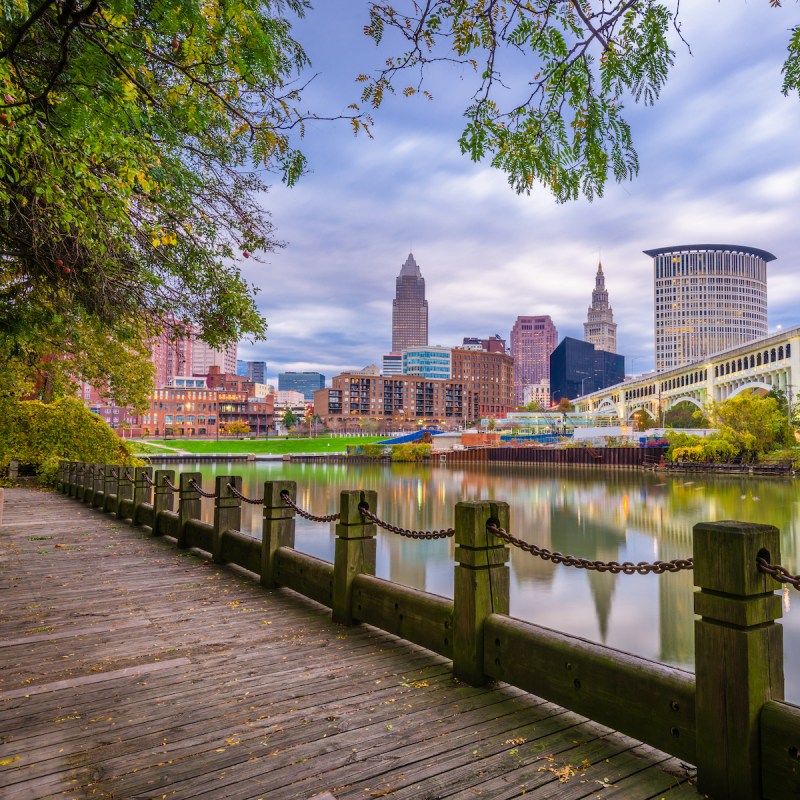
In the 1980s, I fled Cleveland and headed for the East Coast. It was a bad time for that wrecked Rust Belt town with its once powerful heavy industry and proud middle-class workforce ravaged by economic and cultural change, its infrastructure crumbling, and its civic pride in the tank. The sports teams were intractable basement dwellers. The city’s river, the Cuyahoga, was so polluted it caught fire. Then came the Cleveland jokes: “The mistake on the lake” and “Detroit without the glitter.” The name of downtown’s major landmark, the Terminal Tower, seemed more like a diagnosis than a destination.
Videos by TravelAwaits
But that was then.
In 2011, I reconnected with an old college friend and have visited at least once a year since. And I’m here to verify that, yes: Cleveland rocks.
And I don’t mean just the Rock & Roll Hall of Fame, though, of course I mean that too. I also mean that Cleveland is a city that’s found its footing, its history, and its swagger. It has a new identity as a proud, poly-ethnic, eccentric midwestern town with a high quality of life and open arms, national-class eating and drinking, and a lovable bunch of only-in-Cleveland things to do.
Here are seven:

1. The Rock & Roll Hall Of Fame And Museum
The iconic pyramidal structure, designed by I.M. Pei and looming on the Lake Erie shore, houses a museum that tells a well-curated story of rock music, its influences, and its influence. The Rock Hall, as it’s known by locals, features a bewildering number of amazing, amusing, and alarming artifacts. Over the years, I’ve seen Elvis’s late-in-the-game spangle-wear, John Coltrane’s saxophone, draft lyrics scrawled by Kurt Cobain, and artifacts telling the story of the legendary CBGB club in New York, where punk and New Wave were so messily birthed.
Last time I was there, the museum was showing a 1969 film documenting an impromptu London rooftop concert by the Beatles. It’s all rough and unscripted, providing a vivid view of their personalities in the prickly later years. It was their last public performance together.
Pro Tip: Check out the second-floor Garage, a music lounge stocked with instruments. Here, visitors participate in impromptu jam sessions on banjos and mandolins, teenage kids pound out hellacious rhythms on the drum kit, and people like me plink at the synthesizers and Stratocasters.

2. A Christmas Story House & Museum
Admit it: You’ve seen Ralphie almost shoot his eye out with his new Red Ryder BB gun so many times you can lip-sync the scene. And so you must head to A Christmas Story House, which is where the low-budget childhood holiday movie was set and partly shot in 1983.
Nobody expected the movie to succeed, much less become a cult classic. Certainly not one where, 40 years later, people from all over the country (even in July!) file through to see the house where original props and period fixtures are displayed. It’s all there, from the metal sign the fated BB ricochets off en route to the lens of Ralphie’s glasses, to the 1930s-style kitchen where the Christmas turkey was cooked and then devoured viciously by the neighborhood dogs. Of course, the leg lamp is displayed in the front window.
Pro Tip: You can buy a replica leg lamp at the gift shop across the street.

3. The West Side Market
Before there were grocery stores, there were big urban food markets where householders bought their meat, produce, spices, cheeses, and so on. Few of those markets have remained as active, fulfilling their original purpose and evolving only begrudgingly, as thoroughly as Cleveland’s West Side Market, opened in 1912. The massive yellow-brick main hall is packed with almost 100 stalls. The Polish family’s meat counter is over there, the Italian pastry shop is right across the way, and the European-style fromagerie is tucked at the end of that row. The adjacent produce building puts your Kroger’s skimpy aisle to shame.
It’s a scene, it’s a retro adventure, and it’s a great place to grab a serving of perogies or a handmade kielbasa on an old-school white-bread bun loaded with horseradish, sauerkraut, and stadium mustard.
Pro Tip: Be sure to grab a coconut bar. Created in Cleveland, it’s a cuboid of moist chocolate or vanilla cake frosted with chocolate and rolled in coconut. You’re unlikely to find them anywhere but Cleveland.

4. The Cuyahoga River Bridges
Most of the steel mills are gone, but a handful of gorgeous, ingeniously working bridges from Cleveland’s muscular industrial years remain. Many carried railroad tracks over the Cuyahoga, allowing huge cargo boats bearing coal, bauxite, and so forth to pass underneath. Employing 19th-century state-of-the-art engineering, they lift, they spin, they jackknife. Many are in view as you drive around downtown, but for close-ups, you can cruise through the low-lying Flats.
Pro Tip: Try a self-guided tour of a few of the finest Cuyahoga River bridges, with places to stop for a drink or a bite along the way.

5. The Cleveland Museum Of Art
As Cleveland became the nation’s center of industry in the late 1800s, a lot of people got staggeringly rich. Happily, some of them endowed world-class cultural institutions that continue to thrive. The diamond is the Cleveland Museum of Art, a grand 1913 building with a couple of modern annexes and a spectacular covered atrium that joins the classical and modern sections.
Name a famous artist, and they are represented in the 45,000-item collection: Carravagio, Renoir, van Gogh, Gaugin, Dali. The collection spans nearly every culture, from Mesopotamia to Warhol. Unfortunately, you’ll probably never cover all 500,000 square feet. It’s sometimes considered the second-most important art collection in the nation, surpassed only by New York’s Metropolitan Museum of Art.
Pro Tip: Check out the Thinker statue overlooking the Wade Lagoon. It was purchased in 1916 directly from the artist Auguste Rodin. Anarchists bombed it in 1970, blowing out the base and lower legs. The museum left it as is, a testament to how art can provoke and endure.

6. The Guardians Bridge
If you’ve wondered why the Cleveland Indians were rebranded as the Guardians, cross the circa-1932 Lorain-Carnegie Bridge. The eight imposing figures, 42 feet tall and in high Deco style, not only provide metaphorical civic security but, for some odd reason, depict a history of transportation from stagecoach to truck. The bridge joins the east and west parts of the city, divided by the Cuyahoga and a long-standing but largely amicable cultural rivalry. Both parts of the city take pride in the artistry and eccentricity of the bridge. And so: The Cleveland Guardians. You can see the stadium from there.
Pro Tip: Rent a scooter for a close-up view of the guardians.
7. The Buzzards Of Hinckley
Every March 15, a massive flock of buzzards swoops into a Metropark in Hinckley, Ohio, about half an hour south of downtown Cleveland. The city embraces them as if they were the swallows of Capistrano, only with silent, ugly vultures that scavenge animal carcasses. The watch party is a mix of bird watchers and beer-drinking tailgaters who show up for a whacky Groundhog Day.
The whole thing started in 1818 when a property owner brought in the buzzards to clean up after a big shooting party that killed off the many land critters that had been wrecking his crops. The birds obliged, but apparently didn’t like Cleveland winters any more than the native humans, and so they head south every year when it gets cold.
An odd, only-in-Cleveland note: WMMS 100.7 FM — the local radio station that put Cleveland on the map in the ‘60s and ‘70s as a national force in nurturing and showcasing classic rock — long called itself “The Home of the Buzzard.” Its grinning wicked-buzzard logo was ubiquitous. So, in a way, even a flock of big, ugly, crazy birds makes Cleveland rock.
Pro Tip: Hinckley Reservation is the birds’ summer home, so you can see the odd creatures most of the year, roosting and patrolling the skies, looking for dead animals on the ground.
